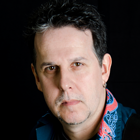More
- Symphonic Legato WorkoutLEVEL 5A lesson to help you work on your pull-offs and hammer-ons. An exercise based on the dominant and root chords of many different keys with a symphonic backing track.
- Symphonic MetalLEVEL 8Rhythm, dynamics, expression and phrasing in a Symphonic Metal setting.
- 6 Power Rock Ballad LicksLEVEL 8Improve your phrasing vocabulary!
- Funk RockLEVEL 6Improve your rhythm chops with 8ths / 16ths syncopations
- Catchy Pop Rock soloLEVEL 6Playing the "right" solo in a Pop song can be a challenge! So here is some playing tips for you.
- Fusion Guitar Synth RockLEVEL 8Phrasing techniques inspired by keyboard players like Jan Hammer, Herbie Hancock, etc.
- Slow PhrasingLEVEL 6Expressive phrasing at a slow tempo is as challenging as it gets!
- Dann Huff (Giant) StyleLEVEL 8Dann Huff's style and phrasing during his time with the band Giant.
- 12 Flashy Repeating Rock LicksLEVEL 7Flashy repeating rock licks to spice up your solos!
more
easier
Feedback
 greedy123416th September 2020
greedy123416th September 2020nice one
 Guido Bungenstock19th March 2020
Guido Bungenstock19th March 2020THX! I love you too! :-D
santos19th March 2020
I love you
 Guido Bungenstock17th November 2019
Guido Bungenstock17th November 2019Many THX! ;-)
 Beat Zbinden17th November 2019
Beat Zbinden17th November 2019Great Guido!!! I like this melody!!!
- Lesson
- My notes
Hi Guys,
Welcome to my lesson No. 97 called "Symphonic Rock
[...]Progressive rock (shortened as prog; sometimes called art rock, classical rock or symphonic rock) is a broad genre of rock music[8] that developed in the United Kingdom and United States throughout the mid- to late 1960s. Initially termed "progressive pop", the style was an outgrowth of psychedelic bands who abandoned standard pop traditions in favour of instrumentation and compositional techniques more frequently associated with jazz, folk, or classical music. Additional elements contributed to its "progressive" label: lyrics were more poetic, technology was harnessed for new sounds, music approached the condition of "art", and the studio, rather than the stage, became the focus of musical activity, which often involved creating music for listening rather than dancing.
Prog is based on fusions of styles, approaches and genres, involving a continuous move between formalism and eclecticism. Due to its historical reception, prog's scope is sometimes limited to a stereotype of long solos, long albums, fantasy lyrics, grandiose stage sets and costumes, and an obsessive dedication to technical skill. While the genre is often cited for its merging of high culture and low culture, few artists incorporated literal classical themes in their work to any great degree, and only a handful of groups purposely emulated or referenced classical music.
The genre coincided with the mid-1960s economic boom that allowed record labels to allocate more creative control to their artists, as well as the new journalistic division between "pop" and "rock" that lent generic significance to both terms. Prog saw a high level of popularity in the early-to-mid-1970s, but faded soon after. Conventional wisdom holds that the rise of punk rock caused this, but several more factors contributed to the decline.[9] Music critics, who often labelled the concepts as "pretentious" and the sounds as "pompous" and "overblown", tended to be hostile towards the genre or to completely ignore it.[10] After the late 1970s, progressive rock fragmented in numerous forms. Some bands achieved commercial success well into the 1980s (albeit with changed lineups and more compact song structures) or crossed into symphonic pop, arena rock, or new wave.
Early groups who exhibited progressive features are retroactively described as "proto-prog". The Canterbury scene, originating in the late 1960s, denotes a subset of prog bands who emphasised the use of wind instruments, complex chord changes and long improvisations. Rock in Opposition, from the late 1970s, was more avant-garde, and when combined with the Canterbury style, created avant-prog. In the 1980s, a new subgenre, neo-progressive rock, enjoyed some commercial success, although it was also accused of being derivative and lacking in innovation. Post-progressive draws upon newer developments in popular music and the avant-garde since the mid 1970s. [...] WIKIPEDIA
In this lesson we gonna learn a simple melodic rock solo based on chord progressions from band like Dream Theater, Yes, ELO or even Movie scores etc.
The structure of the Jam track:
A Part/b] 0:00-0:19
| F#m | F#m E/G# | A | A D |
| A/C# | D A/C# | Esus4 | E C#/E# |
[b]A Part/b] 0:20-0:32
| F#m | F#m E/G# | A | A D |
| A/C# | D B/D# | Esus4 | E C#/E# |
[b]B Part/b] 0:33-0:47
| Bm | Bm A/C# | D | D B/D# |
| Em | D | A/C# G/B A | G C#/E# |
[b]A Part/b] 0:48-1:18
| F#m | F#m E/G# | A | A D |
| A/C# | D A/C# | Esus4 | E C#/E# |
| D | % | % | % |
Have fun! ;-)
[b]Final words
I tried to transcribe as close as possible. Specially in the Guitar Pro file you'll find all this little extras!
Cheers - Guido
Technical specifications
Guitar: Music Man Luke II
Strings: Elixir Optiweb 9-42
Audio Interface: Focusrite Saffire PRO 24
Recording SW: Logic Pro X, several plugins
Kemper Profiling Amp: Soldariu SLO
Matrix GT1000FX with ENGL 2x12" V30 (for monitoring)
The profiles are available for purchase here:
http://www.guidorist.com/en/product-category/kemper-amp-profiles/
Standard Tuning E, A, D, G, B, E
Tempo: 136 BPM







Scrubbing / forward / rewind: arrow right, arrow left keys
Jump to start: Home or `s` , you can also click/tap the lesson part again (the numbers above player)
Go to next part: PageUP or End.
Volume: ArrowUp / ArrowDown keys
Go to any part: Number keys (combinations also possible)
Pause or play: `k` or space key
Fullscreen: `f`, esc to close
Increase / decrease speed : `+` or `-`
Jump to start: Home or `s` , you can also click/tap the lesson part again (the numbers above player)
Go to next part: PageUP or End.
Volume: ArrowUp / ArrowDown keys
Go to any part: Number keys (combinations also possible)
Pause or play: `k` or space key
Fullscreen: `f`, esc to close
Increase / decrease speed : `+` or `-`







